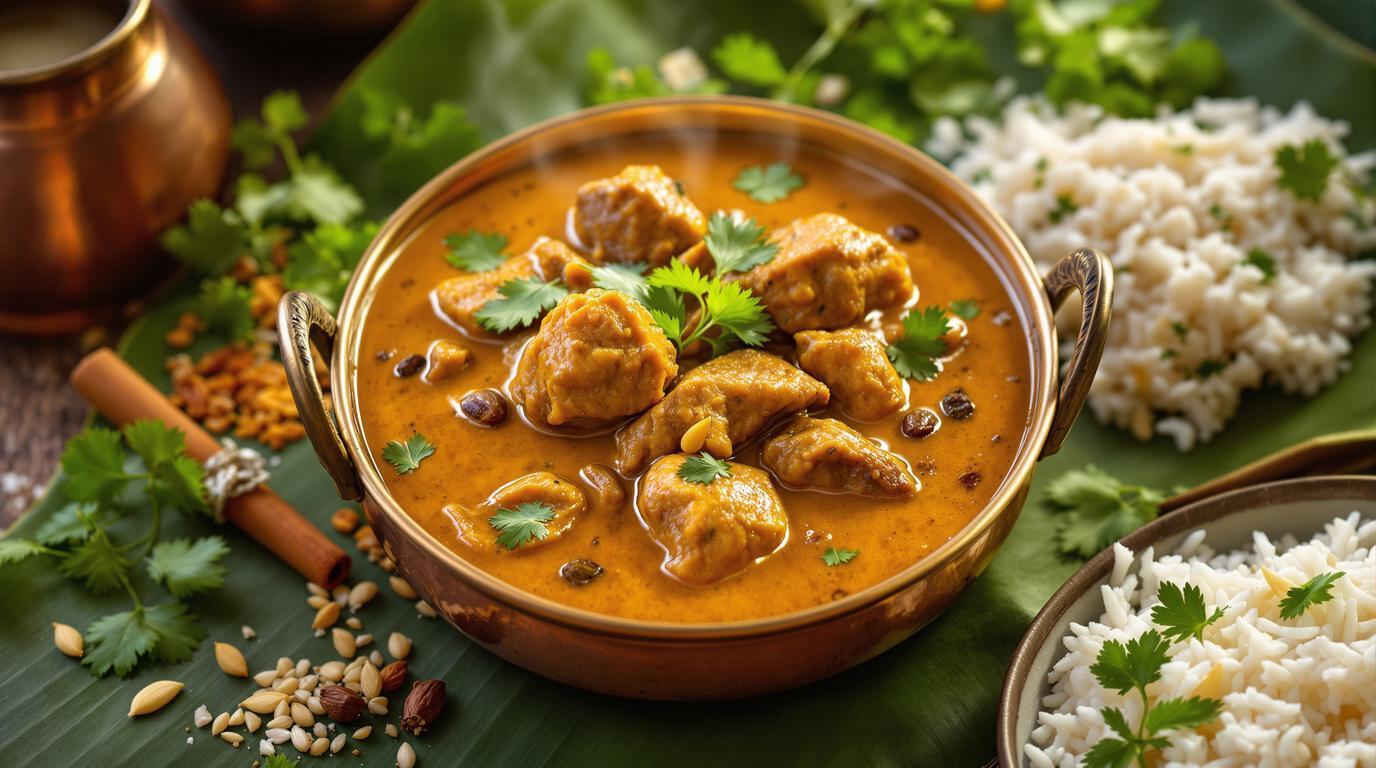The first time I encountered authentic mutton curry with coconut milk, I was staging at a restaurant in Kerala where the head chef—a formidable woman in her sixties—refused to write down her recipes. “The hands remember what the mind forgets,” she’d say. What struck me was how she transformed humble ingredients into something transcendent through patience and precision. That perfect balance of aromatic spices against creamy coconut milk creates a sensory experience that’s both comforting and complex—exactly what we’re creating today.
The Story
This mutton curry draws inspiration from South Indian and Goan coastal traditions, where coconut milk has been used for generations to temper robust spices and create silky, complex gravies. Unlike the yogurt-based curries of Northern India, this grandmother-style preparation relies on slow-cooking to develop deep flavors that simply can’t be rushed. It’s the kind of dish that improves overnight as the spices fully integrate with the tender meat and velvety sauce.
Ingredients Spotlight
For 4-6 servings:
- 2 lbs (900g) bone-in mutton pieces, preferably shoulder or leg cuts
- 3 tablespoons (45ml) coconut oil or ghee
- 2 large onions, thinly sliced (about 2 cups)
- 4 cloves, 4 green cardamom pods, 1 cinnamon stick (2-inch), 2 bay leaves
- 1 tablespoon (15g) ginger-garlic paste
- 2 medium tomatoes, finely chopped (1 cup)
- ¾ teaspoon turmeric powder
- 1 teaspoon Kashmiri chili powder (adjust to taste)
- 1 teaspoon cumin powder
- 1 teaspoon coriander powder
- ½ teaspoon freshly ground black pepper
- 1 cup (240ml) thick coconut milk
- 2 medium potatoes, cubed (optional)
- Fresh curry leaves and cilantro for garnish
- Salt to taste
Step-by-Step Guide
- Marinate the mutton: Combine mutton with ginger-garlic paste, turmeric, chili powder, and a pinch of salt. Let rest for at least 30 minutes (or refrigerate overnight for deeper flavor penetration).
- Build the flavor base: Heat coconut oil in a heavy-bottomed pot over medium heat. Add whole spices (cloves, cardamom, cinnamon, bay leaves) and sizzle for 30 seconds until fragrant.
- Develop the foundation: Add sliced onions and a pinch of salt. Cook for 12-15 minutes, stirring occasionally, until they reach a rich golden-brown color—this caramelization is crucial for depth.
- Integrate the aromatics: Add tomatoes and cook for 5-7 minutes until they break down and oil begins to separate at the edges.
- Seal the meat: Increase heat to medium-high. Add marinated mutton and sear for 4-5 minutes until the pieces lose their raw appearance.
- Tenderize: Add 1½ cups water, bring to a boil, then reduce heat. Cover and simmer for 45-60 minutes (or pressure cook for 20 minutes), until meat is fork-tender but not falling apart.
- Add potatoes: If using, add cubed potatoes and cook for another 15 minutes until tender.
- Finish with coconut: Reduce heat to low. Stir in coconut milk gradually and simmer gently for 8-10 minutes (never boil rapidly after adding coconut milk to prevent curdling).
- Balance flavors: Taste and adjust salt. Finish with a sprinkle of garam masala if desired.
Expert Techniques
The true difference between a good curry and an exceptional one lies in the details. For the characteristic silky texture of South Indian curries, gradually incorporate room-temperature coconut milk while the pot is off direct heat. This prevents the fats from separating and creates that coveted smooth finish.
Chef’s Note: For maximum tenderness, I sometimes add a tablespoon of raw papaya paste to the marinade—a traditional enzyme tenderizer that breaks down tough meat fibers. Just remember to wash it off completely before cooking if you marinate overnight, as prolonged exposure can make the meat mushy.
When browning the onions, resist the urge to rush—those 15 minutes of caramelization create complex sugars that form the backbone of your curry’s flavor profile. I’ve found that adding a pinch of salt at the beginning helps draw out moisture and speeds up the process without burning.
Presentation & Pairing Ideas
Serve this curry in a wide, shallow bowl that showcases its rich amber color. I like to garnish with fresh curry leaves quickly fried in ghee until crisp, a scattering of cilantro, and perhaps a few thin slices of red chili for those who appreciate heat. The perfect accompaniment is steamed basmati rice or, for a coastal touch, appams (fermented rice pancakes).
For a complete meal, consider serving alongside a bright kachumber salad with cucumber and red onion, or a simple raita to cool the palate. Wine enthusiasts might appreciate a juicy Grenache or Zinfandel with moderate tannins to complement the rich spices without overwhelming them.
Don’t be afraid to make this recipe your own. The beauty of grandmother-style cooking is its adaptability—add a handful of fresh spinach at the end for color and nutrition, or introduce a touch of tamarind paste if you enjoy tangy notes. The foundations remain the same, but the variations are limitless—just like the culinary journey that brings us all together at the table.
